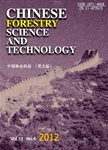Spatial Variability of Soil Saturated Hydraulic Conductivity in a Small Watershed of Loess Hilly Region,China
Spatial Variability of Soil Saturated Hydraulic Conductivity in a Small Watershed of Loess Hilly Region, China出 版 物:《Chinese Forestry Science and Technology》 (中国林业科技(英文版))
年 卷 期:2008年第7卷第2期
页 面:41-48页
学科分类:09[农学] 0903[农学-农业资源与环境] 090301[农学-土壤学]
基 金:National NaturalScience Foundation grant (40474178, 30230290) Shaanxi Provincial Office of Education special projects (05JK241)
主 题:saturated hydraulic conductivity (Ks) spatial variability vegetation distribution pattern
摘 要:Saturated hydraulic conductivity (Ks) is an important soil hydraulic parameter for charactering the rate of water flow across the soils and is mainly related to its high spatial variability. In a small watershed with the area of 0.27 km2 in the Loess Plateau, Ks of 197 soil samples under different vegetations and landforms were measured. Ks had a moderate variability for total samples. The forestland had high Ks with low coefficient of variation (CV), but the grassland in the watershed bottom had low Ks with big CV. Ks had moderate correlation in space distribution and combined both structural and random factors. At the N-S and E-W directions of watershed being parallel and normal to the stream valley, Ks had relatively weak correlation, indicating that the random factor was the dominate reason causing spatial variance. At the NE-SW and SE-NW directions, Ks had relatively strong correlation due to structural factors such as geomorphology and vegetation distribution patterns. Kriging optimal estimation method was used to produce Ks contour map. The Kriging standard deviation (SD) was the lowest near the sampling points, and increased along with the distance to sampling points. In the Loess Plateau region, soil texture is relatively even, and the vegetation distribution pattern was the key factor affecting spatial variability of Ks.



